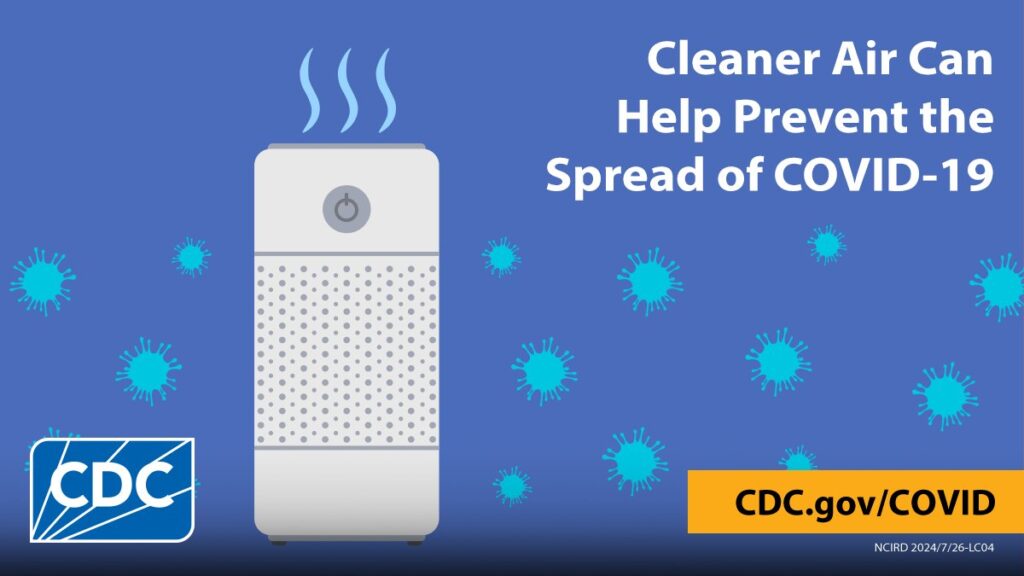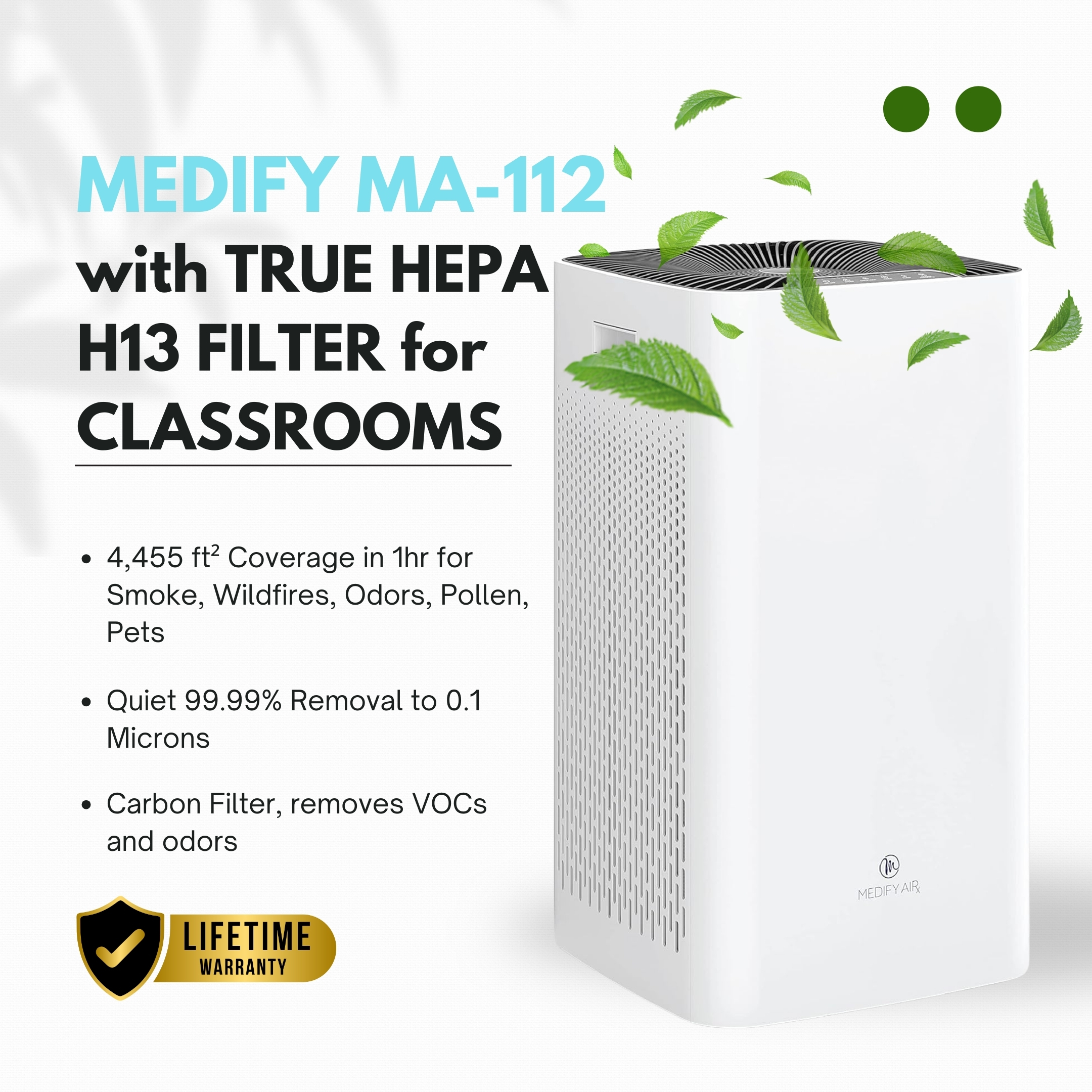Cleaner Air: A Critical Tool for Enhancing School Safety During the COVID-19 Surge and Protecting Vulnerable Children

Cleaner Air in Schools: A Key Defense Against Rising COVID-19 Cases
As the 2024 back-to-school season progresses, the nation faces an unprecedented rise in COVID-19 cases, surpassing levels seen in previous years. With 44 states experiencing high or very high COVID transmission rates (TODAY.COM), parents and school administrators are increasingly concerned about the safety of children returning to classrooms. In this context, the recent Twitter post by the CDC, which emphasizes the importance of cleaner air to prevent the spread of COVID-19, serves as a timely and essential reminder.
Key Points from the CDC's New Guidelines
Cleaner Air Can Help Prevent COVID-19 Spread: The CDC highlighted that improving air quality through enhanced ventilation and the use of Hepa-13 or 14 filtered stand-alone air purifiers can significantly reduce the transmission of COVID-19 indoors. This message is particularly relevant for schools, where children spend long hours in close proximity to one another.
- Emphasizing the Importance of Air Purifiers: The CDC’s post underscores the crucial role air purifiers play in maintaining cleaner indoor air. By highlighting the effectiveness of these devices in reducing airborne virus particles, the CDC reinforces their importance as a practical and essential tool in minimizing COVID-19 transmission, especially in enclosed spaces like classrooms. This message aligns with broader public health strategies aimed at mitigating the spread of airborne viruses.
Importance of Cleaner Air in Schools
- High Transmission Rates Demand Urgent Action:
- As reported by TODAY, the current COVID-19 wave is the largest recorded during a back-to-school season, with some regions seeing the highest levels of transmission ever. This surge is especially concerning in school settings (THESPEC.COM), where large groups of children, teachers, and staff are in close contact.
- With COVID-19 levels higher than in previous years, schools must adopt additional precautions to protect students and staff. Cleaner air is a critical component of these efforts.
- Ventilation and Air Purification as Key Mitigation Strategies:
- Ventilation: Ensuring proper ventilation by keeping windows open, using exhaust fans, and optimizing HVAC systems can help dilute and remove airborne particles, including viruses.
- Air Purifiers: The use of HEPA (High-Efficiency Particulate Air) filters in air purifiers can capture virus particles, significantly reducing the concentration of airborne pathogens in classrooms and other enclosed spaces.
- Benefits of Cleaner Air in Reducing COVID-19 Spread:
- Lower Infection Rates: Improved air quality can lead to a substantial decrease in the spread of respiratory infections, including COVID-19. By reducing the viral load in the air, the risk of exposure is minimized, especially in environments with high occupancy.
- Protection for Vulnerable Populations: Children with underlying health conditions, such as asthma or diabetes, are at higher risk of severe COVID-19. Cleaner air can provide an additional layer of protection for these vulnerable students.
- Practical Steps for Schools to Improve Air Quality:
- Assess Current Air Quality: Schools should evaluate their current ventilation systems and identify areas where improvements can be made, such as increasing air exchanges or installing advanced filtration systems.
- Implement Portable Air Purifiers: Deploying portable air purifiers in classrooms, especially those without adequate ventilation, can help maintain cleaner air throughout the school day.
- Educate and Encourage Good Practices: Schools should educate students and staff about the importance of maintaining clean air, including keeping windows open when possible and using air purifiers correctly.
Air Purifiers: Simple, Effective Tools to Mitigate School COVID-19 Spread
As the 2024 back-to-school season continues to be marked by the highest COVID-19 transmission rates on record, there is a pressing need to adopt practical and effective measures to reduce the risk of infection in schools. The CDC’s recent emphasis on cleaner air, highlighted in their Twitter post featuring an air purifier, underscores the importance of this relatively simple yet powerful tool in the battle against airborne viruses like COVID-19.
The Role of Air Purifiers in COVID-19 Mitigation
- How Air Purifiers Work:
- HEPA Filtration (HEPA 13 or HEPA 14): Most air purifiers designed for mitigating COVID-19 use High-Efficiency Particulate Air (HEPA) filters, which can capture at least 99.99% of airborne particles as small as 0.1 microns. Given that the SARS-CoV-2 virus, which causes COVID-19, can be present in droplets and aerosols much smaller than this, HEPA filters are effective at capturing these particles, thereby reducing the risk of transmission.
- Activated Carbon Filters: Some air purifiers also incorporate activated carbon filters, which can help remove odors and some gaseous pollutants, contributing to overall better air quality. While these filters are less critical for removing viral particles, they enhance the general effectiveness of the air purification process.
- Benefits of Using Air Purifiers in Schools:
- Reduction of Airborne Pathogens: Some air purifiers also incorporate activated carbon filters, which can help remove odBy continuously cycling air through a with HEPA-13 or 14 filtered stand- alone air purifiers can significantly lower the concentration of airborne viruses, including SARS-CoV-2, in classrooms and other indoor spaces.
- Improved Air Quality for All: In addition to reducing viral load, air purifiers also help remove allergens, dust, and other pollutants from the air, which can contribute to a healthier indoor environment overall. This is especially beneficial for children with respiratory conditions like asthma.
- Cost-Effective and Accessible: Air purifiers with HEPA-13 or 14 filters are relatively inexpensive and easy to deploy compared to more extensive HVAC system upgrades. This makes them an accessible option for many schools, particularly those with limited budgets for large-scale infrastructure improvements.
- Strategies for Effective Implementation in Schools:
- Placement of Air Purifiers: To maximize their effectiveness, air purifiers should be strategically placed in areas with the highest density of students and staff, such as classrooms, libraries, and common areas. Proper placement ensures that the HEPA-13 or 14 filtered stand- alone air purifiers can capture and filter the maximum volume of air.
- Maintaining and Monitoring Equipment: Schools need to ensure that air purifiers are regularly maintained, with filters replaced according to manufacturer guidelines. This maintenance is crucial to keeping the devices operating at peak efficiency.
- Educating Staff and Students: It is important for school administrators to educate both staff and students on the importance of using HEPA-13 or 14 filtered stand- alone air purifiers and other ventilation strategies. This includes training on how to use the devices correctly and the significance of keeping them running throughout the day.
- Challenges and Considerations:
- Power and Noise Concerns: While air purifiers are generally low-energy devices, their use across an entire school can lead to an increase in electricity consumption. Additionally, some models may produce noise, which could be disruptive in a classroom setting. Schools should consider these factors when selecting models, opting for quieter, energy-efficient units where possible.
- Ensuring Adequate Coverage: Not all air purifiers are designed to cover large areas, so it is important to select models that match the size of the rooms they will be used in. Multiple units may be necessary for larger spaces to ensure adequate air purification.
- Balancing with Other Mitigation Measures: While air purifiers are an effective tool, they should be part of a broader strategy that includes proper ventilation, regular cleaning, mask-wearing (where appropriate), and vaccination to reduce the overall risk of COVID-19 transmission.
Get a Free Indoor Air Quality Consultation Today
Ensure a Healthier Environment for Your School or Office!
Related Posts:

Why HEPA-13 Filters
Steve Fontaine “America’s Indoor Air Quality Expert™” Explains Why HEPA-13 Filtered Air Purifiers Are the Best Choice for Improving Indoor

Maximizing Classroom Air Quality: A Guide to Utilizing Federal Funding and Implementing HEPA-13/14 Air Purifiers for Schools & Classrooms
Maximizing Classroom Air Quality: A Guide to Utilizing Federal Funding and Implementing HEPA-13/14 Air Purifiers for Schools & Classrooms As

Combating Mold in Aging Homes: Expert Solutions for Healthier Living and Better Air Quality
Combating Mold in Aging Homes: Expert Solutions for Healthier Living and Better Air Quality As the housing stock in the
The Importance of Combining Air Purifiers with Other Strategies
- Ventilation:
- Natural Ventilation: Schools should combine the use of HEPA-13 or 14 filtered stand- alone air purifiers with natural ventilation strategies, such as opening windows and doors where possible, to increase the flow of fresh air. This can help dilute the concentration of any viral particles that may be present indoors.
- Mechanical Ventilation: For schools with advanced HVAC systems, ensuring these systems are optimized to provide maximum fresh air exchange is crucial. Air purifiers can complement these systems by filtering air that is recirculated within the building.
- Mask-Wearing and Hygiene:
- Masks as a Complementary Measure: In settings where the risk of transmission is high, particularly in areas with high COVID-19 levels, masks can provide an additional layer of protection by reducing the emission of respiratory droplets that may carry the virus. When used alongside air purifiers, the combined effect can significantly lower transmission risk.
- Promoting Hand Hygiene: Schools should continue to promote good hand hygiene among students and staff. While HEPA-13 or 14 filtered stand- alone air purifiers are effective against airborne transmission, hand hygiene helps reduce the spread of the virus through contact with contaminated surfaces.
- Vaccination:
- Importance of Vaccination: Vaccination remains the most effective measure to protect against severe COVID-19. Schools should encourage vaccination for eligible students and staff, including the newly updated boosters, to enhance community immunity.
- Air Purifiers as an Additional Measure: Even with high vaccination rates, air purifiers serve as an additional safeguard, particularly for those who may be immunocompromised or unable to receive the vaccine.
- Addressing Parental Concerns:
- Reassuring Parents About Safety: As COVID-19 concerns continue, parents may worry about their children’s safety in school. Highlighting the use of air purifiers as part of a comprehensive COVID-19 mitigation strategy can help alleviate these concerns by demonstrating that the school is taking proactive steps to protect students.
- Transparency and Communication: Schools should maintain open communication with parents about the measures being taken to ensure clean air and reduce the risk of COVID-19 spread. This includes providing information on the types of air purifiers being used and how they contribute to overall safety.
HEPA-13 or 14 filtered stand- alone air purifiers represent a simple yet highly effective tool for reducing the spread of COVID-19 in schools, especially during the current surge in cases. By incorporating air purifiers into a broader strategy that includes ventilation, mask-wearing, hand hygiene, and vaccination, schools can create a safer environment for students and staff alike. The CDC’s focus on cleaner air, as reflected in their recent Twitter post, underscores the importance of these measures in our ongoing efforts to combat COVID-19.
Protecting Children: How Cleaner Air Can Help Combat the Largest COVID-19 Wave of the Season
With the ongoing fall 20204 surge in COVID-19 cases during this back-to-school season, particularly among children, maintaining cleaner air in schools is more crucial than ever. The CDC’s recent emphasis on cleaner air, as highlighted in their Twitter post, serves as a reminder of the importance of implementing effective air quality measures to protect students, especially those who are most vulnerable. As schools navigate these challenging times, focusing on air quality can be a key component in safeguarding children’s health and ensuring that educational environments remain as safe as possible.
Why Cleaner Air is Essential for Protecting Vulnerable Children
Practical Measures for Schools to Implement Cleaner Air Solutions
- Increased Vulnerability Among Certain Student Populations:
- Children with Preexisting Conditions: Children with underlying health conditions such as asthma, diabetes, or weakened immune systems are at a higher risk of severe outcomes if they contract COVID-19. Cleaner air can help reduce the overall viral load in the environment, thereby lowering the risk of exposure for these vulnerable students.
- Younger Children: According to the CDC and experts cited in the TODAY article, younger children, particularly those under the age of 2, are at an increased risk of COVID-19 complications. The air they breathe is clean, adds an extra layer of defense and the solution, according to Steve Fontaine, “America’s indoor air quality expert”™, is using HEPA 13 or 14 filtered standalone air purifiers.
- Preventing Outbreaks and Ensuring Continuous Learning:
- Reducing the Likelihood of School Outbreaks: Cleaner air can play a critical role in preventing outbreaks within schools. By decreasing the concentration of airborne viruses, the likelihood of a single case spreading to multiple students and staff members is significantly reduced.
- Minimizing Disruptions to Education: Frequent outbreaks can lead to school closures, quarantine measures, and disruptions to in-person learning. Maintaining clean air helps keep schools open and functioning, ensuring that children continue to receive the education they need without interruptions.
- Creating a Safe and Reassuring Environment for Students and Staff:
- Building Confidence in School Safety: The anxiety surrounding COVID-19 remains high, particularly among parents and educators. By implementing air purifiers and other air quality measures, schools can reassure parents that their children are learning in a safer environment, reducing fears about returning to the classroom.
- Supporting the Mental Health of Students: The pandemic has taken a toll on the mental health of many students. A safe and healthy school environment, bolstered by cleaner air, can help alleviate some of the stress and anxiety that students may feel about returning to in-person learning.
- Developing a Comprehensive Air Quality Plan:
- Assessment and Planning: Steve Fontaine, founder of IAQ Solutions & Consulting Inc., and “America’s indoor air quality expert”™, has worked with thousands of schools. You can get a free consultation by reaching out to him on his website www.stevefontaine-iaq.com. Schools should begin by assessing their current air quality and identifying areas for improvement. This can include conducting air quality tests, evaluating HVAC systems, and determining where HEPA 13 or 14 filtered standalone air purifiers are needed most.
- Incorporating Stakeholder Input: Involving teachers, parents, and students in the planning process can help ensure that air quality measures address the concerns and needs of the entire school community. Do not trust a salesman or a manufacturer. Contact Steve Fontaine. He is known as “America’s Indoor Air Quality Expert”™, and is trusted by state, government, and other municipalities across the United States.
- Investing in Effective Air Purification Technology:
- Choosing the Right Air Purifiers: Schools should invest in HEPA 13 or 14 filtered standalone air purifiers.that are capable of capturing small particles, including viruses. It’s important to select units that are appropriately sized for the rooms they will be used in, ensuring optimal coverage.
- Regular Maintenance and Monitoring: To maintain the effectiveness of air purifiers, schools must establish a routine for filter replacement and device maintenance. Regular monitoring of air quality can also help ensure that the measures in place are working as intended.
- Complementary Measures to Enhance Air Quality:
- Maximizing Natural Ventilation: Where possible, schools should maximize the use of natural ventilation by opening windows and doors to allow fresh air to circulate. This is particularly important in conjunction with air purifiers to further reduce the concentration of airborne particles.
- Integrating Air Quality Education into School Programs: Educating students and staff about the importance of air quality and how they can contribute to maintaining it (such as by keeping windows open when feasible) can help create a culture of health and safety within the school.
- Engaging Parents and the Community:
- Transparent Communication: Schools should keep parents informed about the steps being taken to ensure clean air in the classroom. Regular updates about air quality initiatives and their impact on school safety can help build trust and cooperation from the broader community.
- Encouraging Community Involvement: Schools might consider involving local businesses or community organizations in efforts to improve air quality, such as through donations of air purifiers or funding for HVAC upgrades.
As schools face the challenge of navigating the highest COVID-19 transmission rates recorded during a back-to-school season, the importance of cleaner air cannot be overstated. The CDC’s Twitter post, emphasizing the role of air purification in preventing the spread of COVID-19, highlights a critical aspect of school safety that is often overlooked. By implementing comprehensive air quality measures—including the use of air purifiers, improving ventilation, and educating the school community—schools can protect their students, particularly the most vulnerable, from COVID-19 and other airborne illnesses. These efforts not only help to reduce the spread of the virus but also contribute to creating a safe, healthy, and reassuring environment where children can learn and thrive.
Got questions? Contact us or get free consultation.
Adherence to Guidelines from:
- World Health Organization
- CDC
- EPA
Expert in the field of IAQ
Our seasoned advisors provide trusted solutions to secure your family's or employees' health.
Each case is handled alone
Personalized approach to address your specific air quality needs effectively and efficiently.
Chat with an expert any time
Access our expert advice whenever you need it, ensuring continuous support for your air quality concerns.
Helped install 1.2 Million air purifiers
Proven track record of enhancing indoor environments with our comprehensive air purification solutions.







